Download the expert’s guide to Robotic Process Automation
Humans have always strived to become better at what they do. Challenging the status quo is the norm. How? Well, we moved from plugging wires to establish phone connections to using satellites to transfer our messages, didn’t we?
And we will continue doing so.
Humans love being productive, being better, faster, and more accurate at tasks we perform.
And we are already at the next step. Automation.
We’ve started using automation in our daily lives, from using excel formulas to perform calculations to using Alexa to deliver anything we want. But it is a little more complex than that. Want to learn how companies use automation at scale to make our lives easier? Dive in!
What is Robotic Process Automation?
Robotic process automation is made up of three terms
In layman’s terms, we can say robotic process automation is using robots to automate various processes. That is true.
Robotic Process Automation is the use of software to capture data from documents, standardize data to conduct analytics, trigger actions based on derived insights, and automate manual processes with high efficiency, accuracy, and reduced costs.
RPA automates any tasks that you consider monotonous, tedious, and manual. By doing so, Robotic process automation amplifies your workforce and frees your employees from manual tasks, and allows them to focus on tasks that require human intervention and insights.
Still confused? Let’s look at one example.
What is Robotic Process Automation Example?
Let’s take the example of invoice processing. The steps to invoice processing include: receiving an invoice, scanning and uploading the invoice, extraction of consumption values, and booking of consumption values. (Well, it has a lot more than that, but let’s consider this for a simple example!)
In manual processing, you would require one full-time employee to handle one aspect of this entire cycle. Every employee does their part individually and sends the output across. Given the process is completely human, it is prone to errors, multiple revisions, manual data entry, manual calculations, and long process time.
Consider the second scenario, where once the accountant receives a paper invoice, he passes it on to the software. The software’s inbuilt OCR software will scan and upload the invoice to the system. The Intelligent document processing software will then extract relevant data from the invoice and ensure their multiple checks to maintain the data quality. After this, the data is stored in the ERP systems. This process reduces time to handle, improves efficiency, and frees up the time of the other employees to focus on the analysis of the extracted data and implementation of strategies.
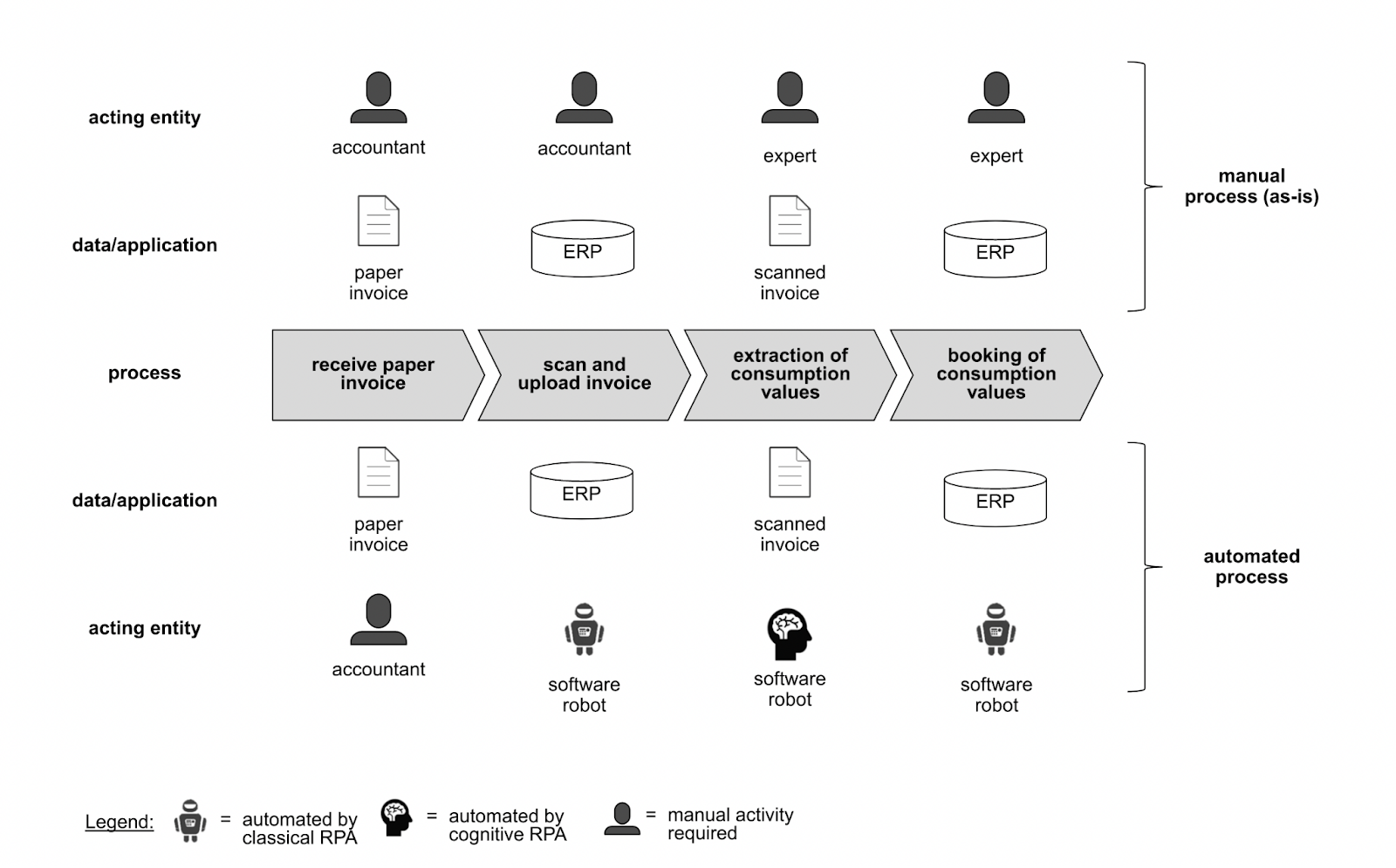
What are different RPA Adoption Trends?
RPA adoption is on rising across industries and for multiple use cases. Let’s take a look at how is the state of robotic process automation adoption by looking at various stats.
Investment in Robotic Process Automation technology is growing
Organizations around the world are focusing on Robotic process automation to achieve their cost-saving goals as mentioned by HfS Research with KPMG.
81% of companies are investing in robotic process automation technology to achieve their financial saving goals.
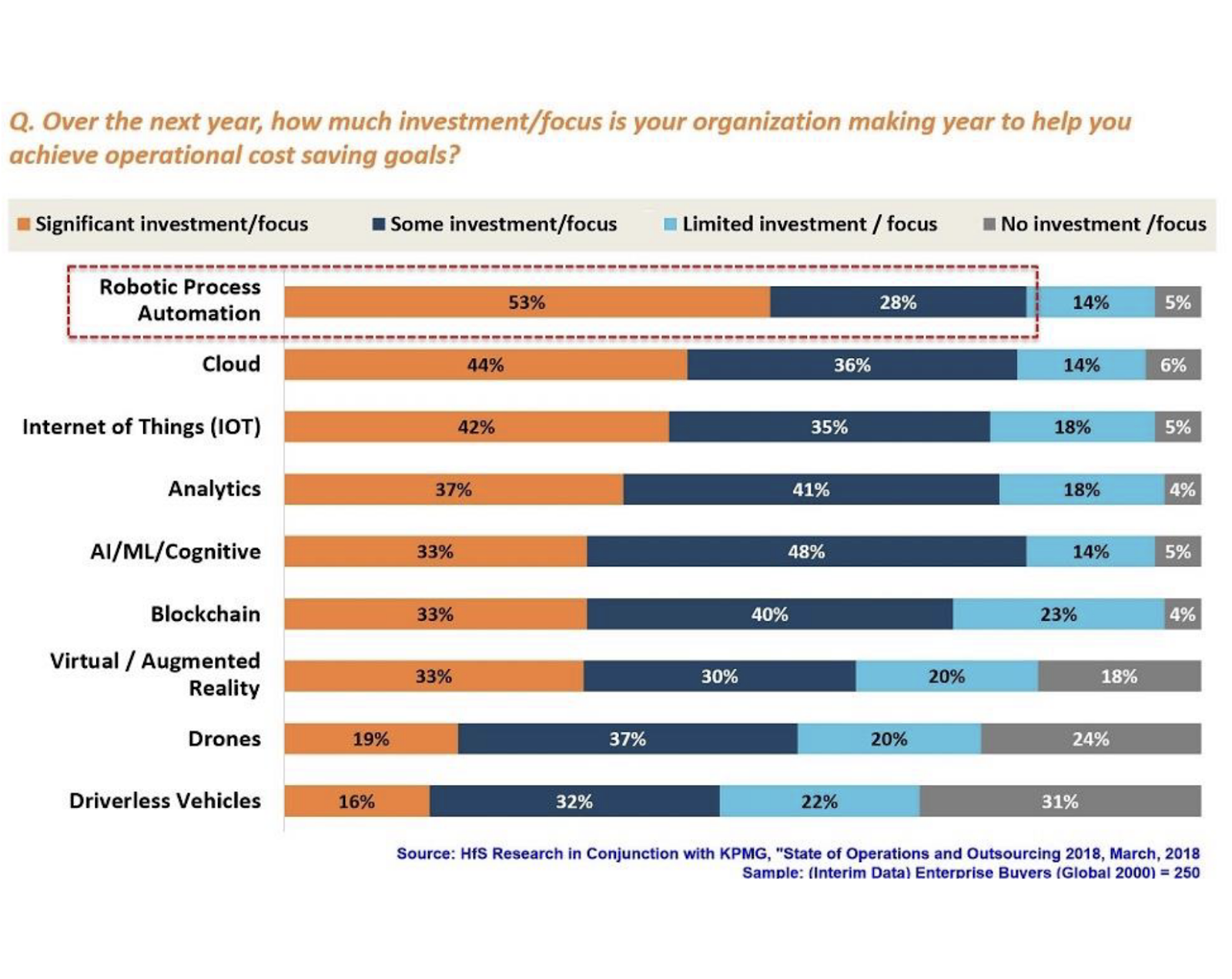
Worldwide RPA Software revenue is on rising!
The worldwide Robotic Process Automation Software revenue is increasing continuously. The revenue from RPA software is expected to reach $1.89Billion with a growth rate of 19.53%.

RPA Market Size Forecasts
- The global Robotic Process Automation market size is already valued at $1.40 billion in 2019 and is expected to reach $11 billion by 2027, expanding at a CAGR of 34% from 2020 to 2027 (Grand View Research).
- By 2025, the market for collaborative robotics is expected to reach $12 billion (MarketsAndMarkets)
- According to Fortune Business Insights, the global Robotic Process Automation Market Size is projected to reach USD 7.64 billion in 2028, at a CAGR of 25.0% during the forecast period. (Embed the code)
- The RPA adoption rates are increasing from 12% in 2019 to 20% in 2021 as mentioned by Computer Economics 2020.
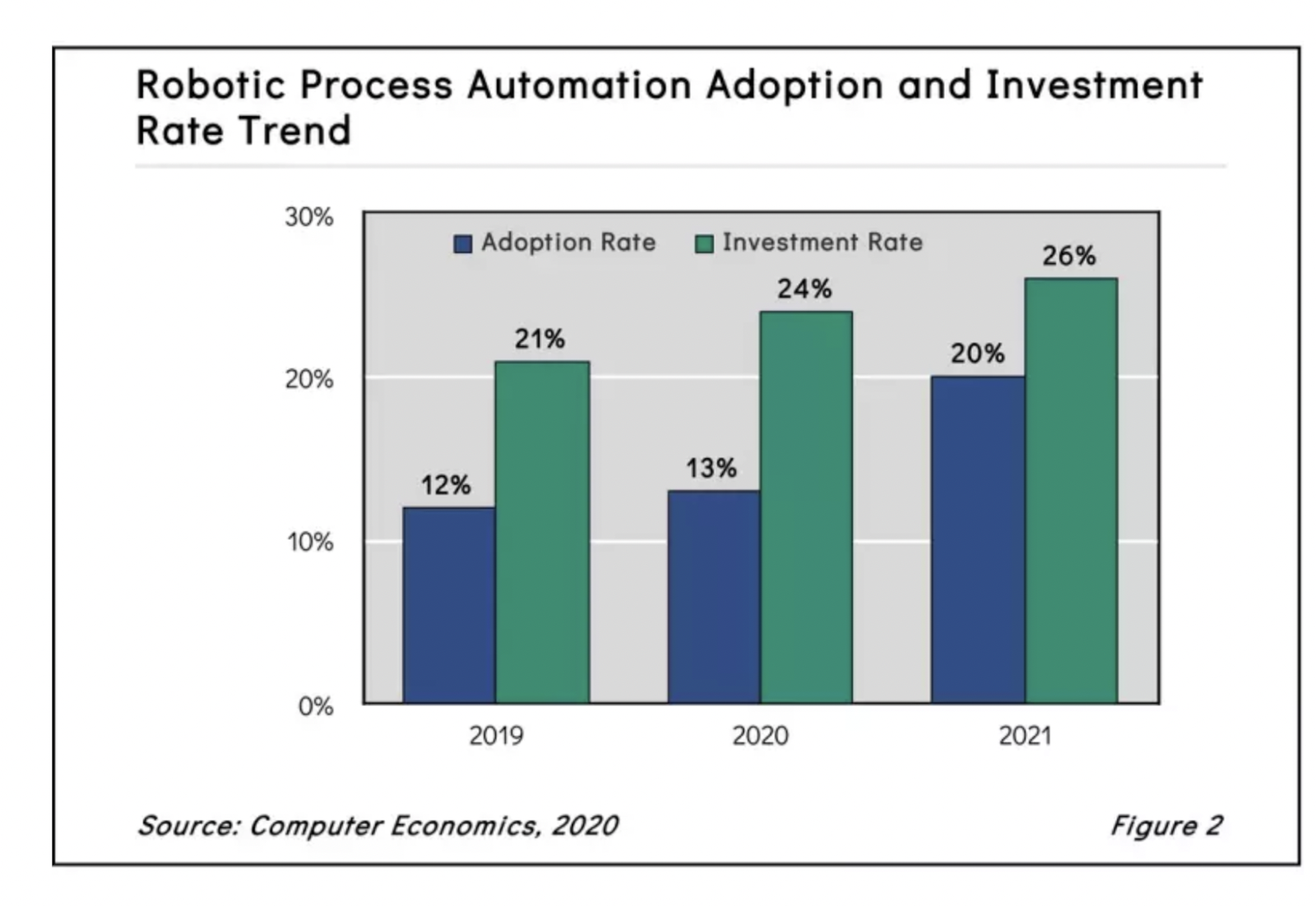
- The Robotic Process Automation industry will generate a total of around $22.5 Billion by 2025 according to the following Forrester image.
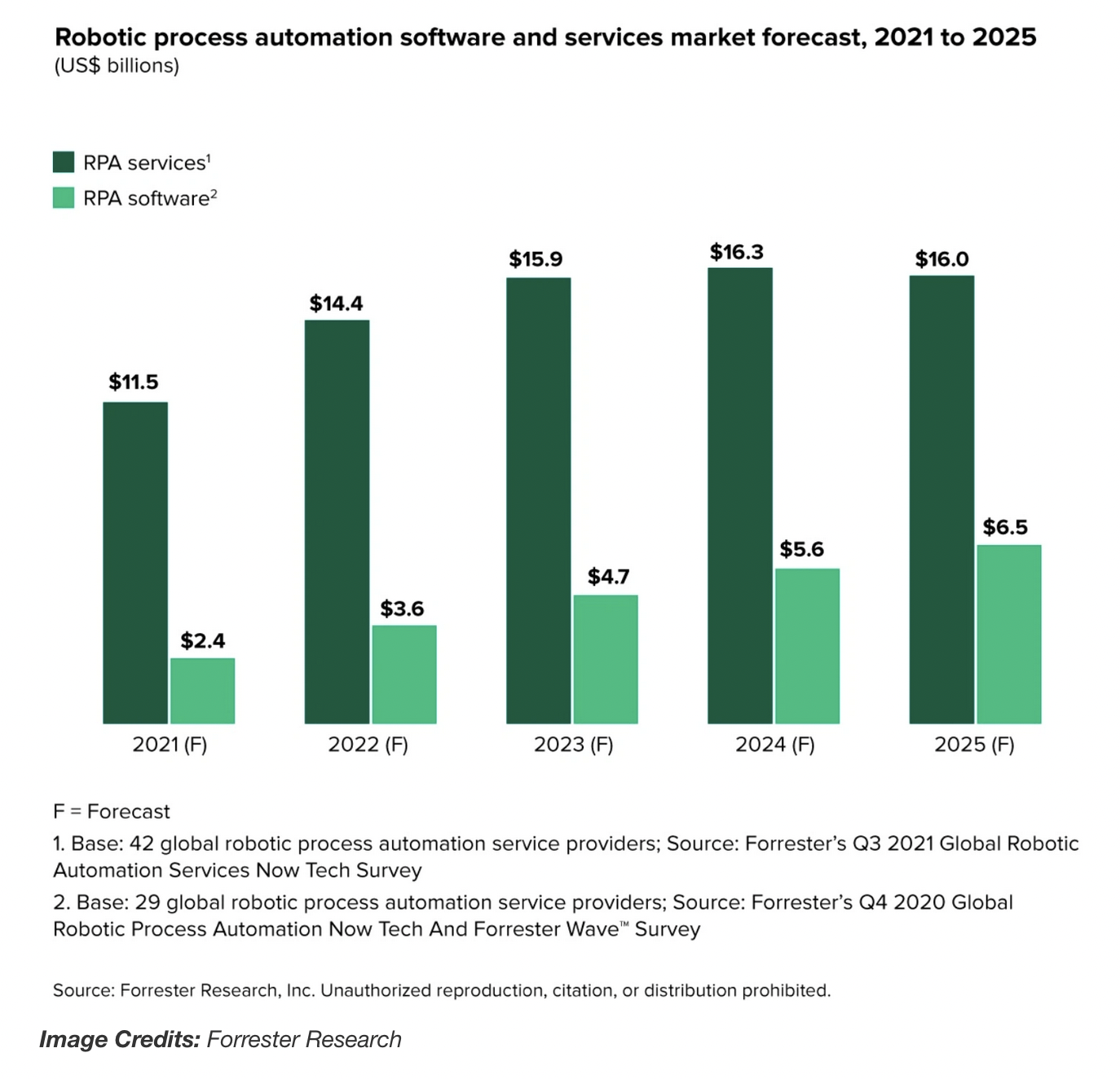
RPA Adoption is rising
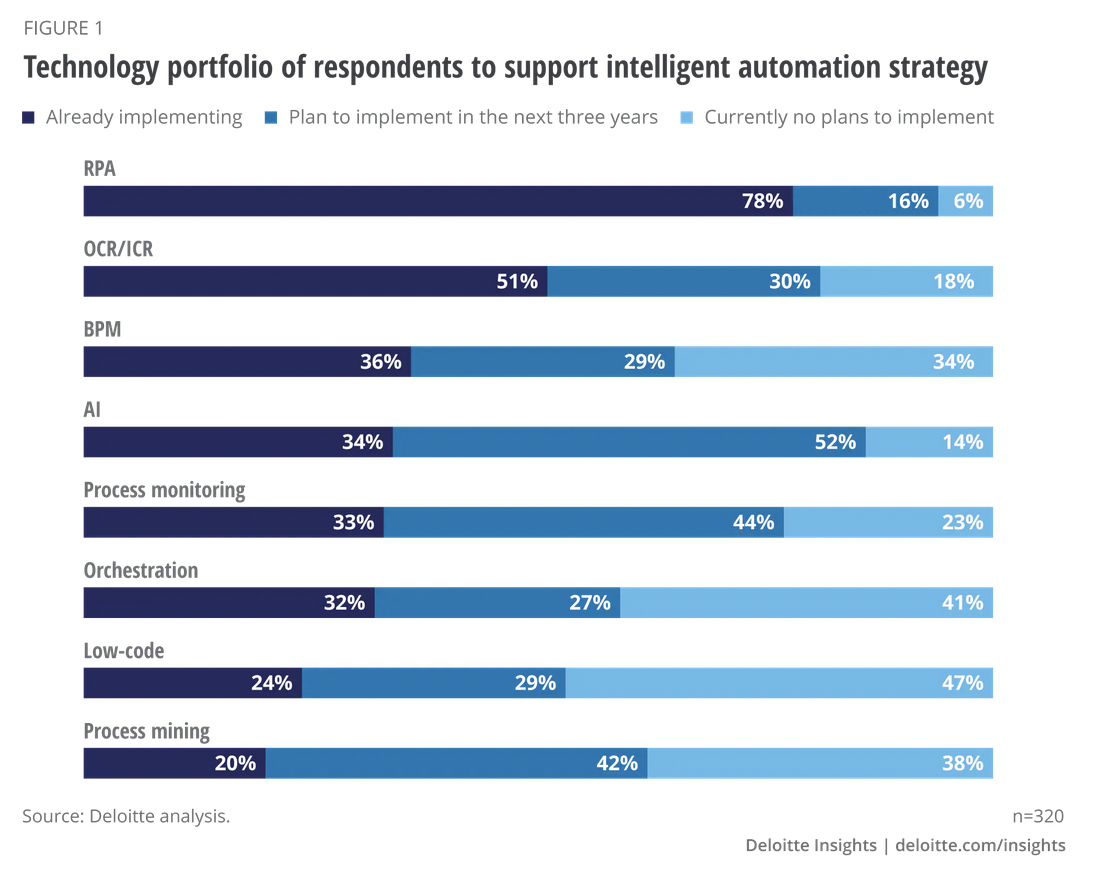
Over 78% of companies are already implementing RPA in their processes whereas an additional 16% are planning to implement RPA in the next 3 years.
Robotic Process Automation is used across industries.
RPA adoption is on rising across different functions. RPA for finance will grow around 12.7 times its current adoption rate in the next 2-3 years. RPA for HR will grow over 3.7x times, RPA in procurement will increase by 4.3 times its current size while GBS will increase by 5.2 times in the next 2-3 years.
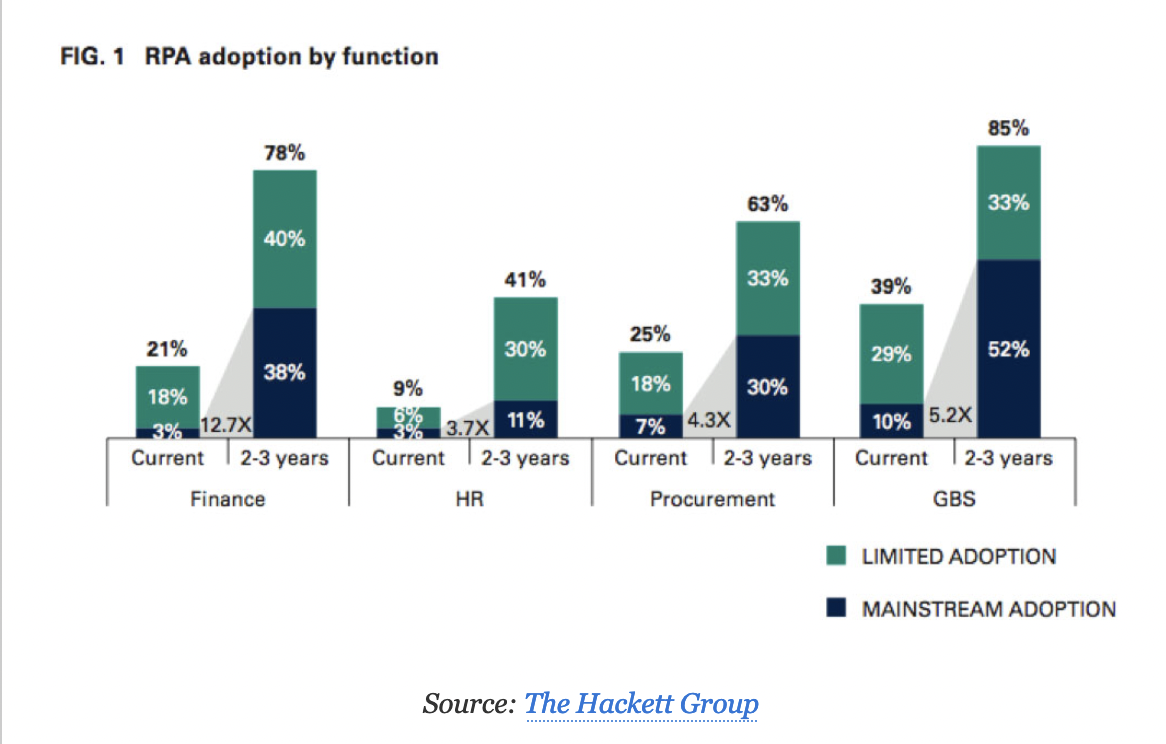
According to HfS Research, the maturity of robotic process automation across various functions is mentioned below:
- Insurance – 38%
- Retail – 36%
- Energy – 30%
- Healthcare – 30%
- Manufacturing – 28%
- Banking & Financial Services – 24%
- Healthcare – 22%
Looking to automate using RPA? Try Nanonets and automate manual tasks with intelligent workflow automation in 15 minutes.
No code, No hassle platform.
What are the benefits of implementing Robotic Process Automation?
The benefits of robotic process automation go beyond just saving money. There are multiple ways in which Robotic process automation contributes to the organization’s growth. Let’s take a look at the benefits of implementing robotic process automation.
Reduction in Employee Load
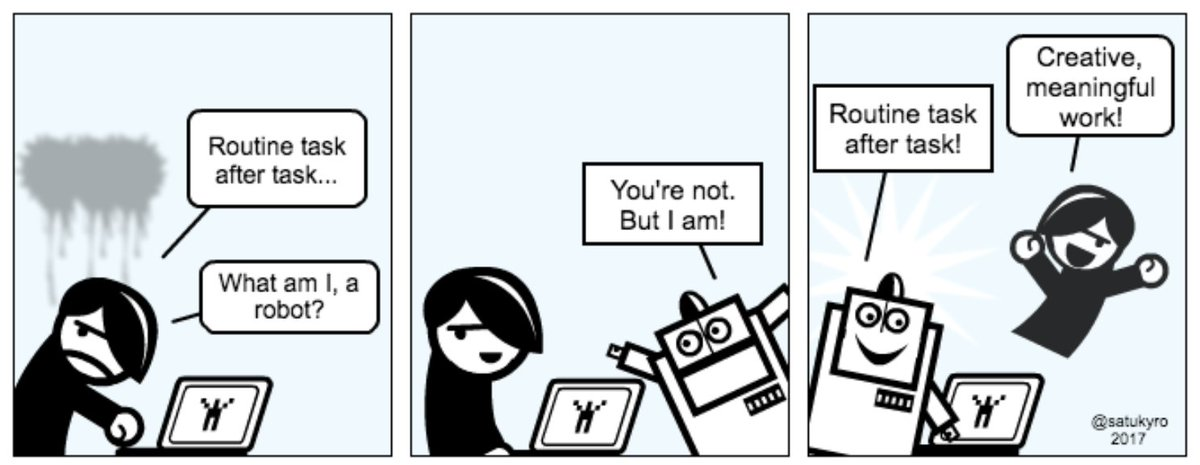
Robotic process automation takes care of all manual data entry tasks so that your employees have more time to focus on the strategic part of their roles. Taking time from tedious data entry, employees focus on providing better services to their customers.
An example where RPA helped in reducing employee load: In healthcare, doctors spend over 66% of their time doing manual paperwork! Using robotic process automation to automate document processes will free up doctors’ time and they can treat more patients in the long term.
Improve overall efficiency
Robotic process automation can create bots or automated workflows that work 24×7. This allows organizations to be available round the clock for their customers. Also, using Robotic Process Automation reduces the cost to serve a customer, improves turnaround time, and reduces human-prone error. It is a win-win for everyone involved!
An RPA bot can displace up to 30x work done by a human employee!
Enhanced Data Consistency
With robotic process automation, every set of data undergoes the same set of rules and standardization techniques. The decision is completely rule-based and there is no ambiguity involved. The RPA output data is, therefore, streamlined, consistent, and standardized.
Improve Data Logs
Audits are not uncommon. Companies have to maintain multiple logs for the audit. Robotic Process Automation can help companies maintain data logs, including every single change made in the document, processes, or any other rules.
Reduction in Errors
Manual processes are prone to error. Robotic process automation reduces the error rates of any manual process.
Software like Nanonets can extract information from documents with an accuracy of 95%.
See how to automate document processes with Nanonets. Try Nanonets for free.
Saves Time
It is no surprise that automating manual processes will save time. RPA can speed up manual processes by 20 times!
Improve Customer Experience
Customers hate waiting.
RPA can reduce the time taken for completing manual tasks. Using RPA, companies can cater to their customers quickly and efficiently. This reduces customer churn and improves customer satisfaction.
Better Compliance & Data Security
RPA bots can be used to streamline, optimize and standardize any fragmented processes. Robotic Process Automation helps in improving the consistency of the processes while ensuring compliance.
RPA will be able to handle operations such as checking all the rules that organizations have to follow, maintain relevant data logs, and prevent data leaks. RPA software is also designed to be secure and adhere to multiple security requirements like GDPR, ISO, SOC2, etc.
Enhanced Control & Expertise
With in-house Robotic Process Automation options, organizations can have increased control over their data and their processes. With extra time on their hands, employees also shift their focus to high-impact areas and develop the expertise required for the company’s growth.
Added Competitive Advantage
RPA can provide high ROI in a short period of time. Consider Nanonets. Nanonets can provide an ROI of 3-4x in a period of 3-5 months! That’s quick.
Also, with Robotic Process Automation, your company can serve your customers at a lower cost, with high efficiency and improved turnaround times. With RPA, you can streamline all the processes and thus, gain a competitive advantage over your competitors.
What are the barriers to implementing Robotic Process Automation in organizations?
Deloitte’s study identified the top barriers to scale intelligent automation in organizations. This gives us an idea to what are the barriers to implementing RPA in organizations.
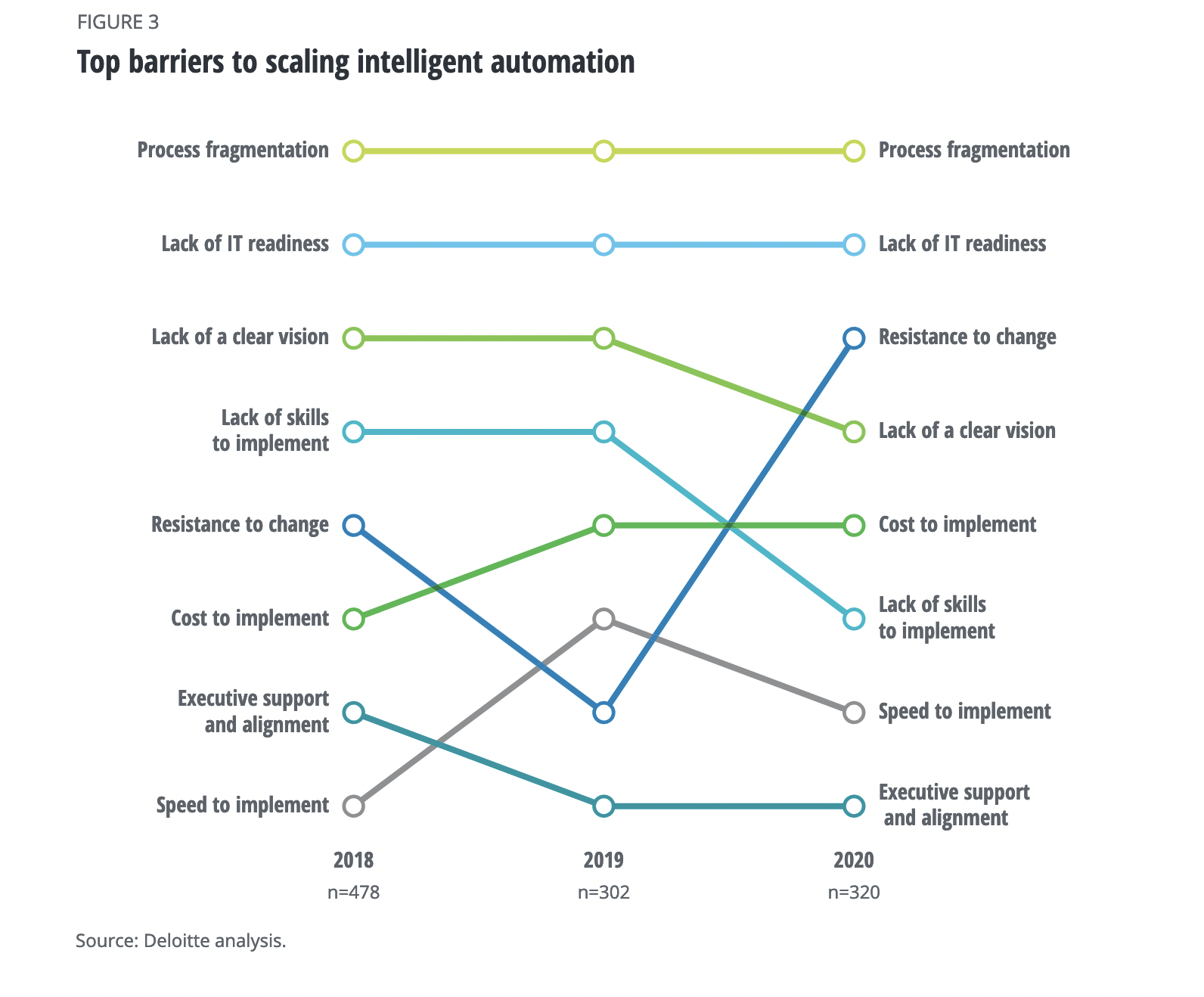
We will discuss the above and some more challenges to RPA implementation in an organization. As a leader, you have to be cognizant of everything that could go wrong with the implementation of new technologies. Without correct implementation, you would never see the benefits of the underlying technology. Let’s deep dive into the challenges to RPA in organizations :
Process Fragmentation
Trying to automate processes that do not have a complete flow or are fragmented can lead to increased errors. For example, you’re trying to automate invoice processing with RPA. But your process has two contractors which cannot be accounted for in the process automation. Trying to automate this process will not be fruitful. There are multiple reasons why the process can be fragmented. Therefore, organizations must ensure that their processes are mature enough to automate.
Only 38% of organisations have mature process definitions, standards, and management [Deloitte]
The above statistics make it difficult to embrace the end-to-end automation of processes. Therefore, before even starting on RPA projects, companies need to identify the correct processes to automate.
Lack of IT support
IT teams are always stretched out and overworked. They’re the team that should lead any automation projects throughout the organization. Even when they’re supportive, they might not be fully equipped to carry out large-scale RPA implementation as shown by the following:
37% of organizations reported that they have appropriate standards controlled by an intelligent automation centre of excellence [Deloitte]
Employee Resistance
“People fear what they don’t understand”
When you mention automation, the first thought in your employee’s head might be about “job security”. By being transparent about the project scope, goals, and vision, you can mitigate the fear. Include employees in every step of the project to reduce the fear of losing their job and gaining momentum to implementation.
Lack of a clear goal and vision
Automation just for the sake of automation will not yield results. It might actually complicate things beyond repair. In order to reap the benefits of RPA automation, organizations must have a clear idea about the following:
- What processes to automate?
- What tools to use?
- What metrics to track?
- How to communicate RPA projects to the employees?
- What are the costs and benefits of RPA implementation in long term?
Costs to implement new technologies
Cost is a major barrier when introducing new technology to the organization. But, this could be easily tackled with a detailed cost-benefit analysis. The benefits of Robotic Process Automation can be quantified for better ideas.
Management & Executive Support
You would think with an extensive cost-benefit analysis you would have executive buy-in. You’re mistaken. Most executives tend to look at the employee sentiment strongly and therefore, getting executive buy-in becomes difficult. Also, they might think that RPA is just a fad and not so relevant to their business because they’ve seen many fads come and go.
But with rampant adoption across technology leaders, this is slowly changing as shown by the figure below. The Deloitte study shows while the C-Suite and functional leads are supportive of the intelligent automation strategy, most of the workforce and risk teams are averse to the idea of RPA automation.
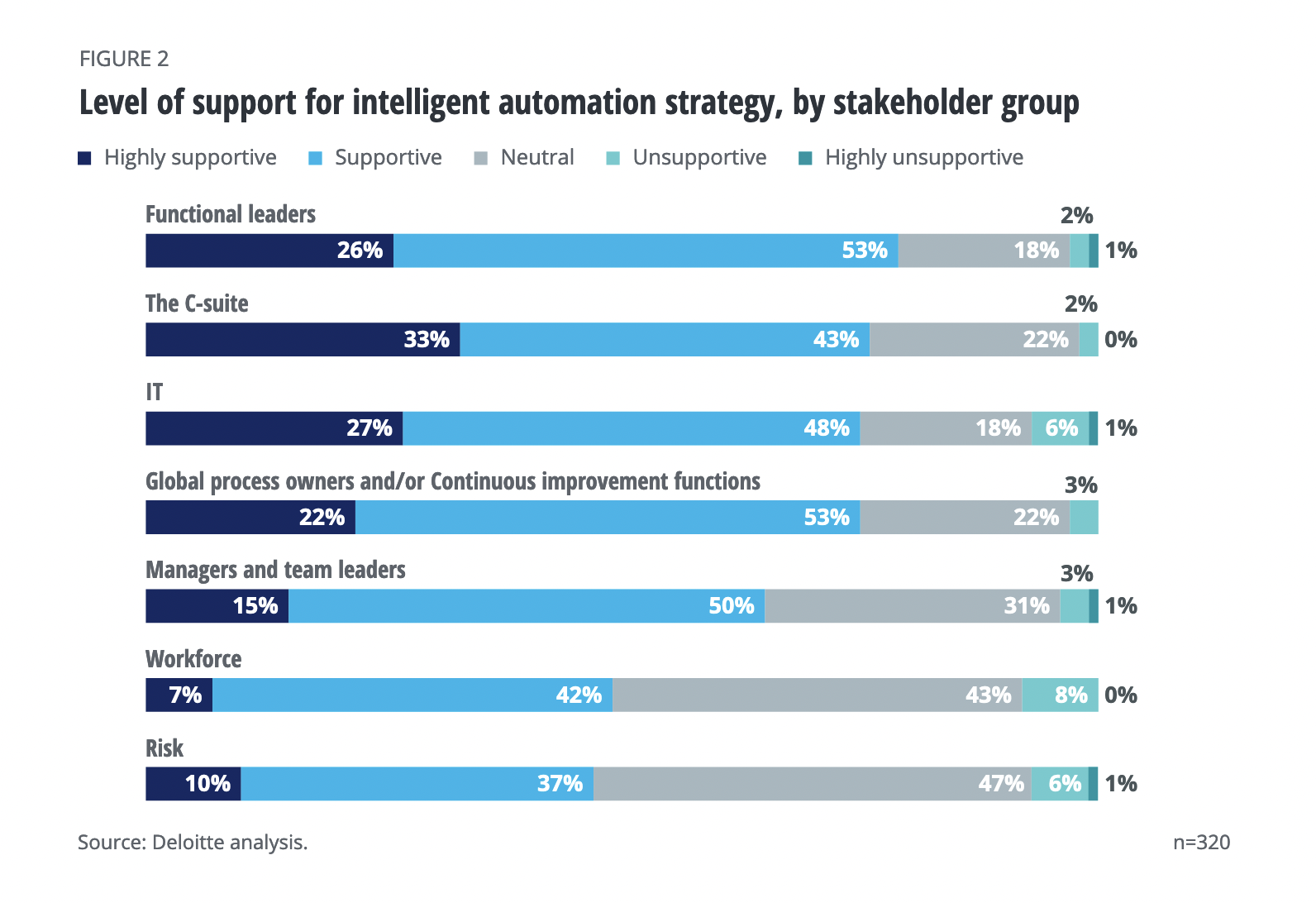
Want to automate repetitive manual tasks? Check out Nanonets RPA software. Extract data from invoices, identity cards or any document on autopilot!
What are different RPA use cases in different industries?
RPA is used across industries for multiple use cases. Let’s discuss RPA use cases in detail.
Robotic Process Automation in Insurance, Banking & Finance
Claims Registration
Claims processing necessitates gathering vast amounts of data from many sources. Current claims systems are inflexible and lack functionality, resulting in extensive human processing.
RPA can reduce human intervention in insurance claim registration. Customer details are validated against internal policy details, customers are notified with claim numbers, and requests are forwarded to the proper investigative teams.
By integrating RPA for Claims Documents Processing, insurance companies can save up to $14k per year in the process.
Read more: Invoice Automation
Fraud Detection
When it comes to fraud prevention, robotic process automation (RPA) can be of immense help.
American insurance companies lose approximately $40 billion a year to scammers.
Considering that many organizations still rely on outdated rule-based systems incapable of identifying sophisticated fraud schemes, the figures seem understandable. Aside from that, AI-powered fraud detection systems help to increase the accuracy of human analysts’ judgments by providing them with relevant data to consider.
Read more: How to prevent vendor fraud?
Underwriting
Underwriting is another area of insurance that can benefit from automation. It involves obtaining and analyzing data from a range of sources.
Insurance underwriters are responsible for assessing and analyzing the risks associated with insuring individuals and their property. Insurable individuals’ and assets’ histories are gathered as part of the underwriting procedure.
Pricing
Several businesses may offer your items at a lower price (one that is theoretically impossible to match) in an effort to increase sales. RPA insurance bots gather and aggregate pricing data to see if your products are being offered online in an unethical manner or for less than the MSRP you’ve established.
Rating, quoting, binding, issuing, renewing, and endorsing are all aspects of insurance policy administration. Using RPA, tasks like credit control, tax compliance, and regulatory settlements can be automated. The whole procedure is sped up significantly using RPA, which navigates across various apps and saves significant time.
Process & Business Analytics
Insurance service providers must strive to give their consumers the finest possible service.
It’s tough for insurance agents to track or measure operational efficiency and find areas for improvement because of the sheer quantity of paper-intensive and operational activities.
When RPA is utilized in the workplace, tasks can be easily executed and tracked with higher efficiency. The use of RPA in audit trails helps to ensure regulatory compliance, which in turn aids in the optimization of the overall workflow. With a customer-centric approach, RPA increases customer response times and streamlines corporate procedures.
Read more: What is process automation?
Sales and Distribution
Sales and distribution in insurance can be made easier with RPA. It is possible to automate and set up a variety of activities, from creating sales scorecards to sending notifications to agents.
Finance & Accounts
With RPA in insurance bots, repetitive tasks like copying and pasting, filling out forms, and sending out notifications may be completed with minimal human intervention. Additional benefits include reducing insurance policy footprint and financial transactions, as well as alerts for questionable claims.
Read more: RPA in Banking, RPA in Insurance & RPA in Finance
Want to use robotic process automation? Check out Nanonets workflow-based document processing software. No code. No hassle platform.
RPA in Healthcare use cases
Patient Scheduling
Patients can book an appointment without interaction with medical staff because of Robotic Process Automation technology. Along with reducing the requirement for allocation of resources for booking, this application can strengthen customer relations by allowing patients to schedule appointments more quickly.
Claim Management
The complexities of this process created a medical claims processing services industry that is now worth roughly $4.6 billion.
RPA-driven claims management solutions can reduce the likelihood of human mistakes during the medical billing process. That is advantageous to healthcare providers.
Compliance with Regulatory Requirements
Healthcare providers may track and record each workflow stage in organized log files using Robotic Process Automation, allowing the organization to comply with the auditing process. In addition, because bots will perform these operations, Robotic Process Automation has the potential to increase the confidentiality of data.
Data Entry, Migration, and Extraction
The healthcare sector is heavily reliant on paper-based records as most healthcare companies have divisions that significantly depend on paper documentation.
Since a portion of its dependence is on paper documents, the healthcare industry is an excellent target for digital transformation. Automation of obtaining data from old systems and transferring it into digital systems is possible through RPA bots.
RPA in Telecommunications
Robotic process automation can help telecommunication battle a lot of issues like inadequate data flow, reduction in performance, fluctuating requirements and rampant competitiveness. Let’s take a look at how RPA can help in optimizing telecommunications
Enhanced scalability
Telecommunication operators require a fluctuating workforce. RPA software bots can help telecom operators replicate workflows at any location and upsize or downsize the workload based on requirements without any additional costs.
Improved Data Quality
Telecommunication operators have a lot of data coming in from multiple sources. RPA bots can monitor and optimize the flow of data and instead of storing it in a silo, RPA in telecommunication can help create a standardized database for everyone. This removes data silos and improved data flow from the database to the required employee.
Cost Savings
Telecommunication is a highly competitive market. With many competitors and almost identical offerings, organizations can use robotic process automation to eliminate manual processes, reduce FTE requirements and enhance productivity. By automating menial front and back-office tasks, organizations can minimize expenses and improve ROI.
If you work with invoices, and receipts or worry about ID verification, check out Nanonets online OCR or PDF text extractor to extract text from PDF documents for free. Click below to learn more about Nanonets Enterprise Automation Solution.
Robotic Process Automation in BPO
Customer service
Over 70 to 80% of rule-based processes in customer services can be automated using RPA.
RPA can expedite customer resolution by using a rule-based process to get more information about customer queries, offering DIY solutions, or connecting to the next available customer agent after gathering the required information.
Invoice processing
Invoice processing is another repetitive business process that can cause incorrect payments and time delays if done manually. And RPA streamlines this process by offering timely payment handling.
Invoice processing is challenging as different companies have different invoice formats. But, using software like Nanonets, which can be trained, invoice processing can be simplified and customized according to requirements.
Read more about how Nanonets helped ACM services.
Price comparison
When businesses purchase anything in bulk for their manufacturing needs, the cost is crucial. The cost of these items can make or break the business and impact the ROI significantly.
However, manually taking the time to compare and research the available option can be tricky and cost a lot in the long run. Keeping that in mind, many businesses are not using RPA to handle the price comparison process.
This system can compare various vendors’ quality, reliability, and price and give you the best result.
Data Entry & Validation
In today’s world, Data can come in various shapes and sizes. From machine-readable data to handwritten notes, there are limitless types that data experts face.
As a result, the overall process to read, entry and validation can be a big struggle for data entry professionals. RPA allows the business to free up data entry and validation tasks and automates the process with outstanding accuracy.
Compliance Management
With the power of automation, businesses are now able to streamline compliance management and limit the exposure to risk in the long run. And as organizations evolved, managing more standard compliance with rule-based inputs will not get more complex due to the scalability of the RPA system.
Reconciliation
Reconciliation involves finding out and sorting information related to the expenditure along with balance. Manual doing this can take up a lot of time from the Accounts departments, which can be better utilized elsewhere.
RPA enables the organization to streamline this process and automate the matching and sorting of all payment details for an efficient record reconciliation experience.
Why do RPA projects fail? What are the risks associated with RPA projects?
RPA projects fail, sometimes because of over-expectations and sometimes because of bad execution. Knowing these pitfalls in advance will help you keep a track of what could go wrong and where. Studying these will assist you in being able to proceed smoothly as you work to automate manual processes in your organization:
Identifying the wrong process to automate
Trying to solve the wrong problem will not yield solutions. We have a checklist to identify the proper process to automate. If it is manual and rule-based, automate it. It isn’t that simple. Try to look for things that could stand in the way:
- Is the manager trying to divert the automation to save his team?
- Is the process more complex than it appears?
- Are the rules properly setup up?
- Are the employees aiding the setup of the tasks?
Try to look for places where it could go wrong and keep an eye on it.
Think more about: Who are the people who are particularly protective of their areas? How would you approach them if you are aware of process opportunities in their areas?
Automating the entire process when only a part was a good candidate
This may be an extension of the problem mentioned above. A process can be broken down into multiple smaller steps. Business owners might want to automate all the manual steps to see the true potential of RPA automation, but that would not work that way. Every part of the process will have a definite degree upto which it can be automated. Certain processes might still need human oversight or human touch. Trying to automate these would create issues.
You don’t have to automate everything to see the benefits. You can automate a part of the process and still see the results you wanted.
Not having enough expertise on the team
Once the RPA bot is live, things might go south. The model might not work the way you intended to. And that won’t look great.
It is always a good idea to have one experienced developer on the team who can handle these issues on the go. Futureproof and improve your processes with automation, and maintain them, with developers.
Starting a project without sufficient information
Project requests are there for a reason. So that the person who requests automation can state his/her exact requirements.
You do not want to work on the RPA bot for weeks just to realize that the requirements were different. While starting out with RPA automation, more information about the requirements is better than having less information.
Selecting the wrong tool
Selecting the wrong tool can cause you a double whammy of wasted effort and costs. Choose your RPA tools based on your requirements.
- Got fewer developers? Get a no-code tool.
- Got less budget? Research all inexpensive tools
- Don’t want to code? Get a workflow-based tool.
It’s better to take more time to decide on the correct tool rather than end up with the wrong one.
Want to automate repetitive manual tasks? Save Time, Effort & Money while enhancing efficiency while using Nanonets RPA software.
How to get executive buy-in for RPA automation?
Stakeholder buy-in is important for a successful RPA project implementation. With more companies adopting automation, buying is becoming easier.
More than 90% of C-level executives report some level of intelligent automation already exists within their organizations. (IBM)
But even then, if you could get one buy-in from the executive team, you will have a stage to present your views. Here are 3 ways to get executive buy-in for RPA automation in your organization.
Showcase the Industry standards
Many organizations across the world are adopting automation. Showcase the RPA adoption trends in your industry. Take statistics from any reputed research report to build credibility.
Show the use cases
Sometimes, when a person does the same work for years, they think no one can do it better. They can’t see how their work can be automated. This is a spotlight effect. Giving a third-person view might help them realize their potential. Take a look at all the processes in your organization.
What are some specific processes within your organization that could benefit from automation?
Make a list of some ideas. Mention is any competitors are using RPA to automate these tasks.
Retrain Employees & Create Expertise
When you suggest automation, think about how you’ll counter the job losses. Managers of all levels loathe slicing their team or their budgets. One way to redeploy these employees is: Retrain & Cultivate Expertise.
Train employees, so they can work in tandem with RPA automation while contributing to company growth. Employees can upskill themselves or use their free time to focus on strategy or more. Get help from the HR team to strategize on this aspect of RPA automation.
Cost-Benefit Analysis
Discuss all the benefits of RPA automation in great depth. Show how these benefits can outweigh the cost. Show the rough calculations for ROI and payback periods. Simulations can help too.
The benefits of RPA automation are:
- Improved Customer Satisfaction
- Improved Employee Productivity
- Less Manual workload
- Enhanced Risk Compliance
- Fewer Error Rates
- Financial Savings
- Competitive Advantages
And more.
The Structure of Robotic Process Automation
RPA is a lot of things. Robotic process automation has a lot of definitions. But how would you describe the structure of RPA? How would you classify RPA?
Enriquez et al. (2020) came up with 48 different functionalities to classify RPA systems. That’s a lot. Let’s try to understand the structure of RPA by categorizing it across multiple dimensions.
Business View
RPA can take on different roles based on business objectives: it can either
- Replace an FTE by completely taking over the manual data entry tasks performed by employees
- Support an FTE (help employee do a better job) – eg. providing relevant customer data to the support agent while the agent is talking to customers online
- Do something innovative – like ensuring vendor GST compliance of open invoices by checking vendor defaults in the GSTM database.
Again, taking a look at the complexity of the process involved, RPA software bots can replace humans for routine tasks. RPA software bots can support FTE efforts while carrying out structured tasks like invoice automation. In the case of unstructured tasks, the RPA bots need to work with intelligence.
RPA Capabilities
Under this section, we are trying to see what kind of capabilities can our RPA bot have. The RPA capabilities can be related to:
How the bots are going to interact?
Under this, we determine how the end-users will interact with the bot. Either the RPA bot will interact using an end-user interface, an application, datasets, other robots, or the real world.
Eg. In the case of automating a routing task, you might use software that will collect information from documents and process them.
In case of support, like in case of customer support, the RPA bot will interact with customer emails, a database of customers, and customer reviews to build a proper customer profile.
In case of a new task, the RPA bot might use the images of driving licenses from the street cameras to extract driver information from a database in real-time.
Do we want them to take a decision?
When you’re building an RPA bot, you have to decide whether you want the bots to make the decisions or not.
While the bots automating routine tasks don’t need to make any decisions, the ones doing innovative tasks should be able to take their own decisions to enhance self-learning.
What should be the bot’s self-learning capabilities?
RPA bots replacing human tasks mostly follow rule-based processes and they don’t need to learn. The ones assisting humans might learn from human actions.
On the other extreme, the RPA bots trying to work on innovative tasks need to become better at doing things after every step.
Should the robot be governed by an external party?
As mentioned in the image, the robots automating routine tasks don’t need any governance because the tasks are pretty simple. Whereas in the case of new tasks, human supervision is required to ensure the RPA bot is progressing in the right direction.
Realization View
The realization view talks about the system configuration and system properties that are comparable to other IT systems. In this view, we take a look at:
- Software Type – The RPA software can be standardized SaaS product or could be developed in-house.
- System Complexity – How many systems are connected? Is it a single system or multiple systems that are siloed or completely integrated?
- System Operations – Where is it hosted? Where is the data stored? Cloud, Hybrid, or on-premise model.
Usage Requirements
The usage view talks about the process of selection and automation. Here we consider how the RPA bot is being used.
How are the processes selected?
The processes can either be selected by the end-users, by manual selection where one of the executives selects the process or by centralized selection process where the executive management or entire company chips in. Additionally, the RPA bot can also automatically select the process to be automated by conducting an analysis.
How are the processes automated?
- Are the processes executed individually by the end-users? The process can also be automated by the centralized team. A major difference between RPA to traditional information systems projects is the possibility of an autonomous realization by business units. However, it can be expected that more complex RPA implementations would require the involvement of the IT department.
What can RPA do for you?
If you’re wondering what RPA can do for you and your business, here’s a quick look at some of the benefits:
- RPA is a cost-effective solution that can reduce costs by as much as 50%. It doesn’t require on-site employees, and it doesn’t take up any space.
- The software is versatile and can be used for many different tasks in multiple industries. It can be used across all departments, such as finance, accounting, IT support, leadership management, and more.
- The software is easy to use with minimal training required by users or employees who need assistance using it on the job site.
- The software can automate repetitive tasks and reduce the amount of time it takes to complete those tasks. In addition, RPA software can free up human resources for more challenging or thought-provoking work.
How to select the best RPA software for your organization?
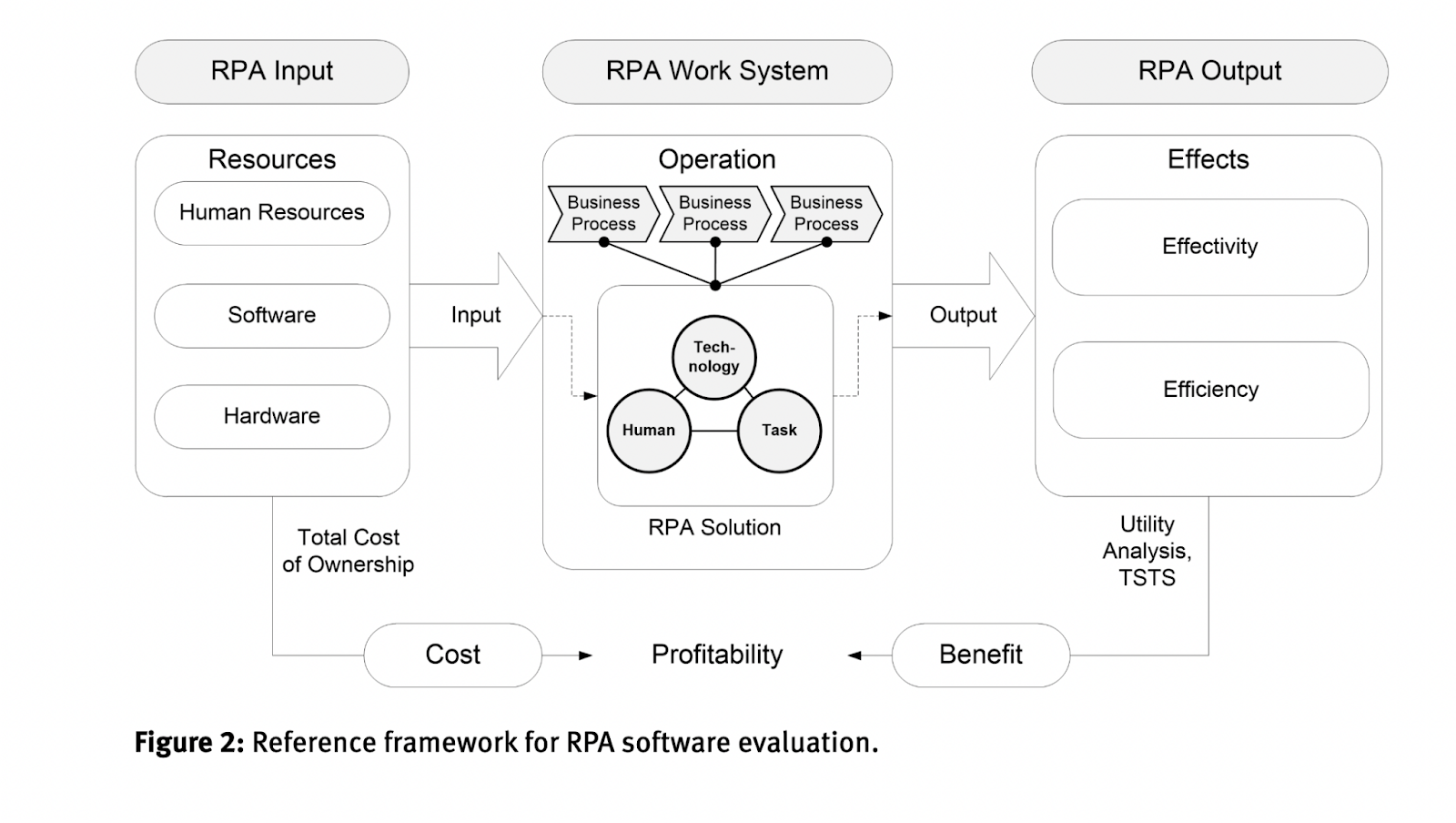
Robotic process automation (RPA), which is viewed as a driver for a beneficial digital transformation, has been expanding worldwide. Robotic process automation will have a nearly $6.7 trillion economic effect by 2025, predicts McKinsey.
As a result, choosing the appropriate RPA software is essential for daily company continuity. When selecting software, one must take certain factors into account in a market that is becoming saturated with RPA companies.
We must keep in mind the goals and needs of the firm while choosing the appropriate RPA tool. The recommendations for selecting the ideal RPA tool are listed below.
Usefulness:
Process automation tasks should be simple to generate for both technical and non-technical users. Both from a technical and end-user perspective, it must be usable. Otherwise, it would be counterproductive to use an RPA.
Easy to integrate:
RPA involves complicated codes that operate in the background and is simple to incorporate. One of the key characteristics of RPA is that it builds and integrates on top of current systems rather than overhauling outdated ones. Consequently, the price of implementation is reduced.
Scalability:
Unpredictable operational spikes. Your RPA software should enable you to scale up in situations like these so that you can finish the procedures in the same amount of time. This adaptability to scale up or down as demand necessitates more productivity is a crucial quality to consider.
Next-gen capabilities:
To effectively meet your organization’s objectives for intelligent process automation, your RPA should offer extensive next-generation capabilities. Avoid “point” RPA systems that need third-party connectors and lack integrated features.
Speed and simplicity:
It is preferable to stay away from a solution that makes you wait weeks for a bespoke coding effort is preferable. A firm should be able to create and test new robotic automation processes using the solution in a matter of hours or less.
Enterprise-grade security:
Make sure the RPA solution safeguards each layer to protect your data and business. Every interaction, including granular, role-based access control and administration, complete integration, secure credential storage, thorough audit logs of all user and system activity, and data modifications, should be highly encrypted.
Reporting:
The program must be able to collect, arrange, and examine data in order to produce a thorough analytical report. This will make it easier to spot operational inefficiencies and areas in need of improvement.
How to implement RPA?
An organization must develop its implementation strategy after choosing an RPA solution. The adoption of RPA involves several crucial processes. You may learn how to strategically plan the deployment, development, and launch of an RPA application by using the four-step method below.
#1 Pick the process you want to automate:
Enterprises looking to utilize RPA may not be successful if they immediately start automating all activities. First, choose a procedure that needs to be automated and implement a trial project. Make a complete review by comprehending the procedure and determining whether the automation is benefiting your company. Look at the possible dangers and predicted benefits of automation. If the pilot is successful, you may decide which more procedures you want to automate.
#2 Reskilling the team:
While automation teaches people that they don’t need to pay attention to procedures, a little amount of human oversight makes sure there are no roadblocks or issues along the way. Tell the team how robotic process automation operates and the major benefits it will provide to the company, such as eliminating duplication or boosting efficiency. You may do training programs along this process to fill up any skill gaps so employees can easily adjust to the shift.
#3 Pick the best vendor:
Every business has different requirements. Select an RPA provider who does a thorough assessment and provides tailored solutions that satisfy your needs with a successful RPA installation. Here is a list of considerations to keep in mind while choosing a vendor:
- Estimated cost and duration for deploying the software bots
- Scaling of bots to deal with surges and financial complexity
- Data encryption solution to protect the confidentiality and privacy
- Systems that issue alerts when a process fault or data breach happens
- Software for performance monitoring that records and tracks the actions the bot takes
- Outstanding technical skills that can adjust to shifting demands and expectations
#4 Specify your goals:
One of the most important stages to take into account while deploying RPA is this one. Create a strategy that outlines the goals you have for automation. Create a clear plan outlining your KPIs, end objectives, and the systematic strategy you will use to implement RPA for your organization. In connection with your pilot project:
- Determine the requirements needed to drive process automation.
- Create a framework with a supplier.
- Utilizing a process map, create an acceptable response.
- The individual automated portions should be noted, clarified, and marked.
- Conduct frank evaluations to identify contradictions and weaknesses in the RPA implementation
- Repeatedly iterate and solve the problems
- Set up bots to deal with changes
Differences between RPA and other technologies
RPA and Intelligent Automation
When examining the market for automation software, there has been a lot of misunderstanding. Even the names given to things appear to grow like bunnies. Analysts, software providers, and solution integrators create and use these phrases as they each strive to differentiate themselves in the market. So let’s quickly review a few of the terminology to help us build our own “decoder-ring” to make sense of it all.
RPA and Artificial Intelligence
RPA and HyperAutomation
10 things to keep in mind while working with RPA
Robotic process automation (RPA) is a powerful tool that can transform your business. Unfortunately, it’s also a mystery to many leaders who have never used it. So what are some realities you should know about RPA?
Catch the Wave of Automation
If you’re waiting to see whether the ideas behind RPA will catch on, you’d best not wait too long since your rivals could overtake you. Automation is a growing trend, but that doesn’t make it hype. Instead, it’s creating waves across various sectors, including business process outsourcing, insurance, telecommunications, healthcare, and financial services.
That’s not hyped if you’ve read all the blogs, webinars, and conferences on the subject. But, it is proof of a significant development that is only now gaining considerable momentum.
The Monetary Effects Could Be Dramatic
RPA can have a tremendous financial impact. It can help to reduce costs, errors, and customer dissatisfaction. For example, RPA reduces the time it takes to process simple tasks such as document review or data entry by using intelligent automation. That means fewer errors and less money spent on training new employees or paying for outsourcing. In addition, RPA helps businesses improve productivity by working smarter instead of harder by reducing idle time due to manual processes.
The Errors Costs Will Fall
RPA is not cheap. However, it will reduce overall costs by eliminating unnecessary labor and automating processes that otherwise take time and money. RPA software can be expensive to buy or build from scratch. Still, considering all the factors involved in implementing an RPA solution—including human resources and technology required—will likely save you money in the long run.
Business Procedures Will Modify
Businesses will be able to do more with less. But you can optimize business processes; your organization becomes more efficient. This may mean that some employees—or departments—will be let go, but there are also opportunities for new roles and responsibilities for those who remain.
When your company uses RPA effectively, the entire workforce may see a shift in their roles or responsibilities. For instance, if your sales team is using RPA software to automate tasks related to lead generation and follow up with leads, this frees up time for them to focus on closing deals or other areas where they can add value for customers.
Users Will Take Note and Request More
Customers will notice, and they’ll want more. Offering customers a consistent level of service is a fundamental part of any business. But when you add RPA into the mix, it’s not just about delivering that same level of service—it’s about providing better service. This means that your customers will be more satisfied with their experience and feel more loyal to you. They might even recommend you to others or buy again from your company in the future.
It’s no secret that automation can improve efficiency across an organization—but did you know it can also positively affect other areas? Implementing robotic process automation (RPA) could lead directly or indirectly to improved customer satisfaction.
Automation Is a Boredom Remedy
Automation is an antidote for boredom. As humans, we get bored when we’re doing repetitive tasks. Automating those tasks helps eliminate redundancy and allows us to focus on more important things. With RPA, you can automate any job that involves a human performing a routine or repeating a process with slight variation. You can also use RPA to automate tasks that are too complex for humans and would take too long to complete by hand or even dangerous ones (like responding in real-time to an emergency).
The Time for Digital Transformation Has Come
Digital transformation is about more than technology. It’s about changing your business practices, processes, and culture—how you interact with customers and approach business. It would help if you changed the way you think about technology as well.
The best way to prepare for digital transformation is through RPA. It’s not just a process automation tool; it’s a platform that can be used across all departments in your organization—from HR to IT to Sales & Marketing—and even extend into other lines of business.
Lessen Your Staffing Sufferings
They’ll probably chuckle if you ask your human resources leadership what an easy day at work is like. Staffing is not a simple task, particularly in areas of your business where demand is uneven, activity levels occasionally fluctuate, and turnover is significant.
Need to accelerate quickly? Do you have employees on hand to hire at a moment’s notice? No chance. Additionally, you cannot instantly hire and train more employees. On the other hand, if volume declines, you may send many people home, but try not to do so too frequently or risk losing valued employees.
Robots, on the other hand, are very simple to scale up and down. They won’t object to being sent home early and can be deployed swiftly and far more affordable. Having the correct number of employees on hand at the appropriate moment is much simpler.
The Talent Landscape Will Evolve
As RPA continues to mature, the talent market will likely change. You should expect more roles to be created in areas like automation programming, automation design and development, process analysis and design, data management, systems integration, and test engineering. These are all areas where people have worked with RPA technology for years but haven’t always had a formal name for them.
The need for new employees won’t just be in these high-skilled roles; there will also be a demand for more technical support personnel and management positions that handle processes related to RPA implementation and operation.
Your Leaders Would Appreciate It
It’s also worth pointing out that RPA is a technology that can automate the majority of tasks for your organization, which will make your leaders happy. Automation will reduce the amount of work that needs to be done and the number of errors, and the amount of time spent on repetitive, non-value-adding tasks.
It’s easy for businesses to fall into a trap where they are constantly hiring more workers to cope with a growing workload, but this doesn’t solve anything in the long term. Instead, automation offers an alternative way forward: using software robots can create efficiencies, so you won’t find yourself needing more people or spending more money over time (which will make everyone happy).
RPA – Best Practices
RPA has enormous prospects for improving productivity and drastically lowering costs, but firms must be cautious about how they do so. A mix of in-depth process understanding, technical know-how, and domain knowledge is essential to ensure the implementation’s success. Additionally, the implementation ought to include the following tried-and-true industry practices:
- Create an Enterprise Automation Roadmap rather than focusing on individual tasks.
- Be reasonable and start small.
- Clearly explain what RPA means to your company.
- Develop the RPA Business Case
- Compile a list of the best-suited RPA scenarios and rank them according to a tried-and-true methodology.
- Select and accept reasonable ROI expectations.
- Create a clear governance framework.
- Make it possible for the business and IT units to work closely together.
- Keep track of bot performance and make sure there is enough oversight
- Share accomplishments and knowledge gained to raise awareness within the company.
- Focus on business strategy flaws rather than technological ones.
Future of RPA
Robotic process automation can completely change how we do business, according to professionals in the BPO and IT industries. So what is in store for the future as RPA spreads throughout the corporate world? According to a McKinsey &
Company report on emerging disruptive technologies, 110 to 140 million full-time equivalents (FTEs) could be replaced by automation tools and software by 2025 if disruptive technologies like RPA are used at the rate which it is anticipated that they will be used.
As organizations become familiar with it, people will rapidly grasp the advantages this potent, developing technology offers over outsourcing and other approaches to business and IT processes. As RPA technology develops, crowdsourcing and impact sourcing may become increasingly important, and new employment may be generated for skilled human employees who can maintain and enhance this technology. In other words, as we move forward, people and robots will collaborate to alter how we conduct business, resulting in lower costs, more efficiency, better customer service, and happier employees.
Many believe that as RPA moves beyond transactional processes to more analytical ones, it will become more cognitive, with the capacity to adapt and evaluate and engage with users, iterate, and comprehend contextual information. In other words, RPA would function just as a human brain would, if not better.
Start your automation journey with Nanonets. Automate any process with intelligent workflows. Try now with a free trial.
Update 13 September 2022: The blog originally published on 27th June was updated on 13 September 2022.
Read more
Financial Automation software
Insurance Automation Software
Logistics Automation Software
Healthcare Automation Software
Retail Automation Solution
Banking Automation Platform





